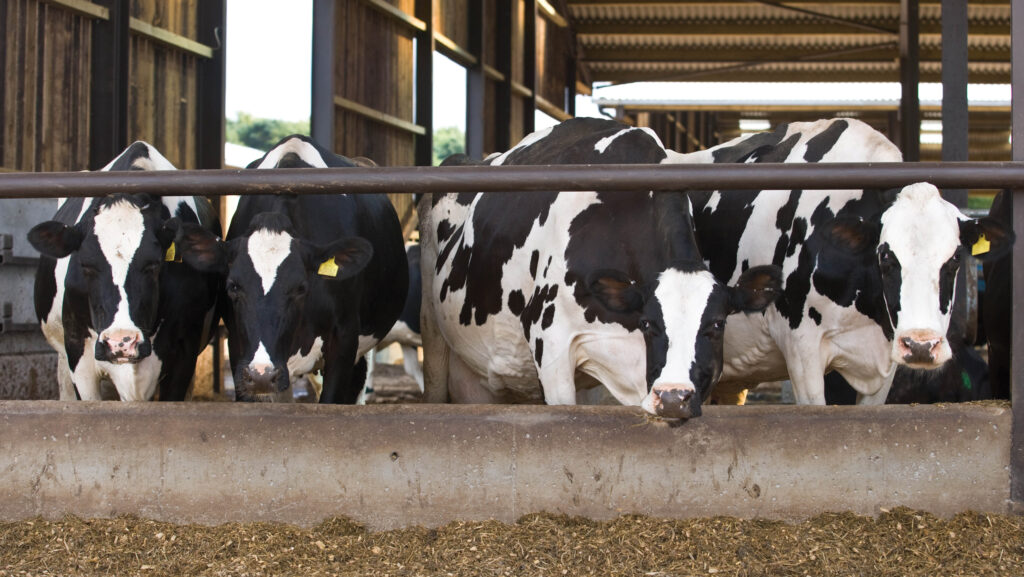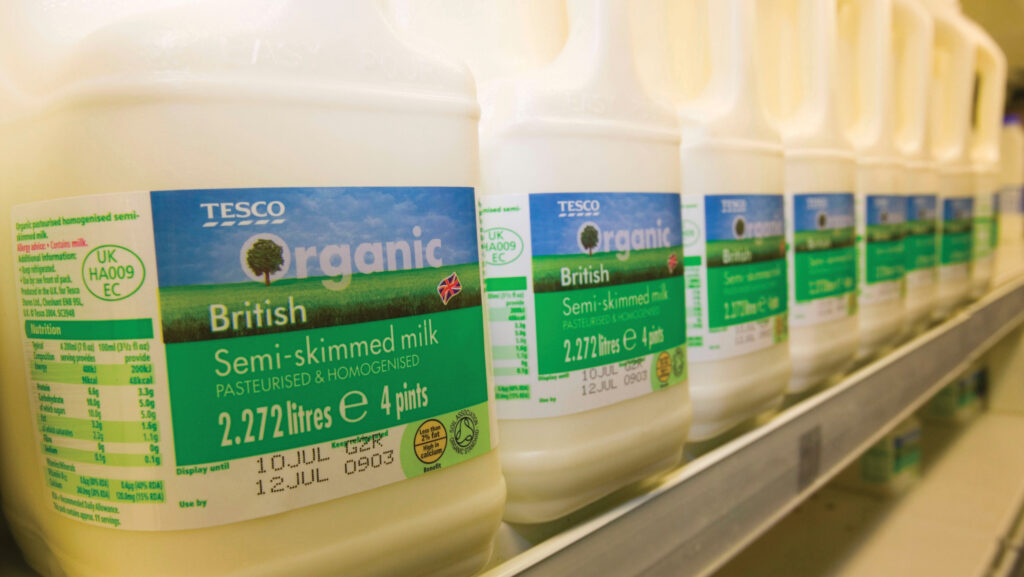Growing performance gap within dairy systems, reveals report
 © Tim Scrivener
© Tim Scrivener The year to the end of March 2025 saw the milk price to concentrate price ratio at its most favourable since 2000, raising margin over purchased feed (MOPF) for most producers.
However, Kingshay’s detailed Dairy Costings Focus 2025 shows that the financial performance gap between the top 25% of producers and the poorest performers continues to grow, both generally and within production systems.
A higher milk price, up 11% on the previous year and averaging 42.44p/litre for conventional herds, gave the strongest MOPF for a long time, save for that seen as a result of the 2022 milk price spike.
See also: How milk recording revival is identifying most efficient cows
Housing-focused, year-round calving herds achieved the highest average MOPF of any system, at £2,937 a cow.
Emma Puddy, farm services specialist at Kingshay, says the range in performance between herds on the same system is wider than the range between systems.
For example, among year-round calving herds with a housing focus, the top 25% had an average MOPF of £3,275 a cow, compared with the bottom 25% which averaged £2,579 a cow.
This represents a cash difference in MOPF over the year of £139,200 for a 200-cow herd.
Among spring-calving herds the top 25% averaged 45p/litre MOPF, while the bottom 25% averaged 28.2p/litre.
The cash difference in MOPF here over the year is £185,300 for a 200-cow herd producing 5,515 litres a cow.
Kingshay costed herds – key figures
The 2025 report is the 14th in Kingshay’s series, in which performance is split by region, milking frequency, milk yield bands, herd size, breed, production system, and milk from forage bands.
- 1,064 conventional herds
- 98 organic herds
- Average milk yield for conventional herds settled at 8,421 litres, a drop of 20 litres on the year.
- Herd size rose by 27 cows to average 226 head
- Yield from forage fell 241 litres to 2,450 litres a cow (conventional herds)
- Average MOPF rose to £2,602 a cow and 30.9p/litre (conventional herds)
- A record number of cows left their herds – 29.2% in the year to March 2025. Age at exit is falling – now down to 3.43 lactations. Forced culls were 63% of these and selected culls 37%. A higher proportion than previously left their herds to be milked on another farm, and high beef prices contributed to the higher cull rate.
- Mastitis rate fell by two cases to 24 per 100 cows
- Lameness dropped by three cases to 34 per 100 cows
- Cell counts have fallen 8.3% in 10 years, standing in conventional herds at a record low of 154,000 in 2024-25
- Calving intervals extended by a day to 394 days
- Days to first service rose by two days to 72
Less milk from forage overall
The percentage of milk produced from forage in conventional herds slipped 8%, to average 2,450 litres, on the back of relatively high volume but poor quality silage from the 2024 crop, alongside a difficult grazing season.
Milk from forage results for the full year were below the five-year average, and poorer than the two previous milk years. However, lower bought-in feed cost a tonne reduced feed cost a litre.
“The higher milk prices and lower feed cost contributed to a healthy increase in margins per cow.” says Kingshay’s development director, Richard Simpson.
“Those increases were absolutely essential to cover all the other rising variable costs and overhead costs and give that opportunity to make a profit.”
Margin a litre
Among conventional herds, the highest MOPF a litre was achieved by spring-calving, grazing-focused herds.
“There’s no best system,” says Emma. “Producers should use our data to compare themselves with similar herds. Clearly there are improvements to be made.”
More purchased feed was fed in the 2024-25 milk year, up 5%, with the 8% drop in milk from forage balanced by lower bought-in feed costs a tonne, resulting in a fall in feed costs a litre.
“Herds that are making more of grazing are aiming to produce more cost-effective litres, they tend to have lower overhead costs, they have lower yields, but their margin per litre is higher than housing focused herds,” says Emma.
“Milk from forage is still very strongly linked to MOPF, with conventional herds in the top 10% for milk from forage achieving a margin that was 20% higher per cow and 14% higher per litre.”
When the milk price falls, lower input systems are more resilient, but all systems can be successful and all can be profitable, says Richard.
Full cost of production
Kingshay also conducts a full cost of production analysis, but with a smaller number of herds.
In general, the cost of production results follow the same pattern as the MOPF costings, says Richard, in terms of which herds produce the best financial results.
Milk producers should do full cost of production calculations once a year and monitor against budgets.
“Monitor the aspects most likely to change quickly, such as milk price and feed costs, and look at what has an impact on overall performance on a monthly basis,” he says.
Milk production systems – results compared |
|||||
|
Conventional herds, all breeds |
Spring-calving herds |
Autumn/split block-calving (grazing focus) |
Autumn/split block-calving (housing focus) |
Year-round calving (grazing focus) |
Year-round calving (housing focus) |
|
Cows in herd |
229 |
199 |
224 |
177 |
266 |
|
Stocking rate (cows a ha) |
2.76 |
2.26 |
2.32 |
2.31 |
2.54 |
|
Milk production |
|||||
|
Milk yield (litres a cow) |
5,515 |
6,671 |
8,649 |
6,837 |
9,775 |
|
Yield from all forage (litres a cow) |
2,750 |
2,691 |
2,827 |
2,347 |
2,293 |
|
Yield from grazed forage (litres a cow) |
1,765 |
972 |
779 |
1,020 |
260 |
|
Number of days grazing |
218 |
239 |
184 |
204 |
144 |
|
Total yield from forage (%) |
50% |
40% |
33% |
34% |
24% |
|
Milk solids (kg a cow) |
446 |
543 |
679 |
549 |
766 |
|
Milk price (p/litre) |
44.52 |
44.85 |
44.25 |
42.73 |
42.36 |
|
Milk price to feed price ratio |
1.43 |
1.46 |
1.46 |
1.37 |
1.38 |
|
Margin over purchased feed (MOPF) |
|||||
|
MOPF (£ a cow) |
1,962 |
2,319 |
2,880 |
2,188 |
2,937 |
|
MOPF (p/litre) |
35.94 |
34.76 |
33.30 |
32.00 |
30.05 |
|
Source: Kingshay Dairy Costings Focus 2025 |
|||||
Organic focus

© Ashley Cooper/Alamy Stock Photo
Organic herds made a strong showing after a difficult few years, with the milk price reaching a record 53.17p/litre in March 2025.
These herds produced an average of 44% of their milk from forage compared with less than 30% for conventional producers.
The highest absolute MOPF a litre in the series was achieved by low- to moderate-yielding organic herds, at 41.15p/litre, while the average MOPF across the organic herds was 39.82p/litre, up 7.05p/litre or 21.5% on the previous year.
Milking frequency – twice, three times and robots
When looking at results by milking frequency, the highest yields were achieved by those on three-times-a-day milking, at 10,620 litres and with a herd size averaging 564 cows.
Robotic milked herds (86 herds in the series) broke the 10,000 litres barrier in the year ended March 2025, averaging 10,041 litres on an average herd size of 185 head.
Herds milked twice a day had an average yield of 8,204 litres and an average herd size of 218 cows.
Results by milking system/frequency |
|||
|
Holstein/Friesian conventional herds |
Twice-a-day milking |
Robotic milking |
Three-times-a-day milking |
|
MOPF (£ a cow) |
2,573 |
3,032 |
3,175 |
|
MOPF (p/litre) |
31.37 |
30.19 |
29.9 |
|
Source: Kingshay Dairy Costings Focus 2025 |
|||
